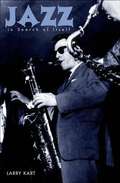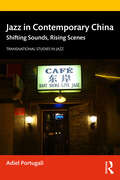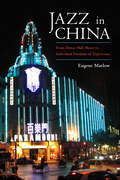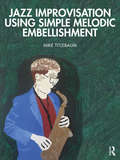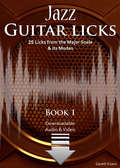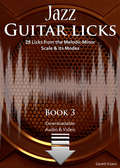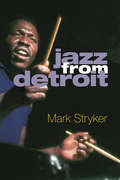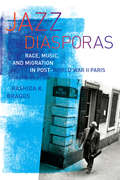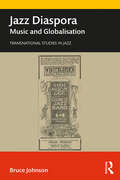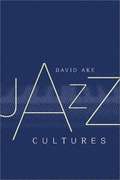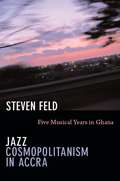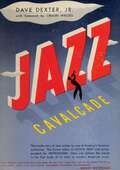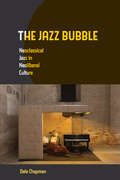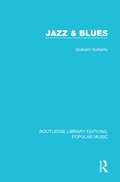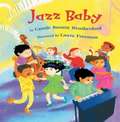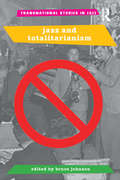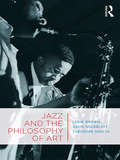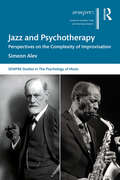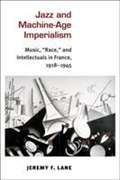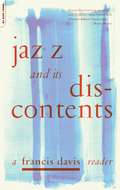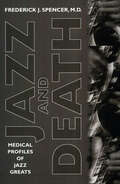- Table View
- List View
Jazz in Search of Itself
by Larry KartIn this engaging and astute anthology of jazz criticism, Larry Kart casts a wide net. Discussing nearly seventy major jazz figures and many of the music's key stylistic developments, Kart sees jazz as a unique perpetual narrative--one in which musicians, their audiences, and the evolving music itself are intimately intertwined. Because jazz arose from the collision of specific peoples under particular conditions, says Kart, its development has been unusually immediate, visible, and intense. Kart has reacted to and judged the music in a similarly active, attentive, and personal manner. His involvement and attention to detail are visible in these pieces: essays that analyze the supposed return to tradition that the music of Wynton Marsalis has come to exemplify; searching accounts of the careers of Miles Davis, Thelonius Monk, Bill Evans, and Lennie Tristano; and writing that explores jazz's relationship to American popular song and examines the jazz musician's role as actual and would-be social rebel.
Jazz in Contemporary China: Shifting Sounds, Rising Scenes
by Adiel PortugaliBased on interviews, conversations, and observations drawn from extensive field research, Jazz in Contemporary China: Shifting Sounds, Rising Scenes explores the current developments and conditions of Chinese jazz. Negotiating socio-political, cultural, and spatial phenomena, the author provides unique insights for understanding China’s modern history through its happenings in jazz, unveiling an insider’s look at the musicians and individuals who populate and propel these scenes. This first-hand perspective illuminates how jazz generates and disseminates practices of creativity and individuality in twenty-first-century China.
Jazz in China: From Dance Hall Music to Individual Freedom of Expression
by Eugene MarlowFinalist for the 2019 Jazz Journalists Association Book of the Year About Jazz, Jazz Awards for Journalism"Is there jazz in China?" This is the question that sent author Eugene Marlow on his quest to uncover the history of jazz in China. Marlow traces China's introduction to jazz in the early 1920s, its interruption by Chinese leadership under Mao in 1949, and its rejuvenation in the early 1980s with the start of China's opening to the world under Premier Deng Xiaoping.Covering a span of almost one hundred years, Marlow focuses on a variety of subjects--the musicians who initiated jazz performances in China, the means by which jazz was incorporated into Chinese culture, and the musicians and venues that now present jazz performances.Featuring unique, face-to-face interviews with leading indigenous jazz musicians in Beijing and Shanghai, plus interviews with club owners, promoters, expatriates, and even diplomats, Marlow marks the evolution of jazz in China as it parallels China's social, economic, and political evolution through the twentieth and into the twenty-first century. Also featured is an interview with one of the extant members of the Jimmy King Big Band of the 1940s, one of the first major all-Chinese jazz big bands in Shanghai.Ultimately, Jazz in China: From Dance Hall Music to Individual Freedom of Expression is a cultural history that reveals the inexorable evolution of a democratic form of music in a Communist state.
Jazz Improvisation Using Simple Melodic Embellishment
by Mike TitlebaumJazz Improvisation Using Simple Melodic Embellishment teaches fundamental concepts of jazz improvisation, highlighting the development of performance skills through embellishment techniques. Written with the college-level course in mind, this introductory textbook is both practical and comprehensive, ideal for the aspiring improviser, focused not on scales and chords but melodic embellishment. It assumes some basic theoretical knowledge and level of musicianship while introducing multiple techniques, mindful that improvisation is a learned skill as dependent on hard work and organized practice as it is on innate talent. This jargon-free textbook can be used in both self-guided study and as a course book, fortified by an array of interactive exercises and activities: musical examples performance exercises written assignments practice grids resources for advanced study and more! Nearly all musical exercises—presented throughout the text in concert pitch and transposed in the appendices for E-flat, B-flat, and bass clef instruments—are accompanied by backing audio tracks, available for download via the Routledge catalog page along with supplemental instructor resources such as a sample syllabus, PDFs of common transpositions, and tutorials for gear set-ups. With music-making at its core, Jazz Improvisation Using Simple Melodic Embellishment implores readers to grab their instruments and play, providing musicians with the simple melodic tools they need to "jazz it up."
Jazz (History of American Music, Ninth Edition)
by Paul O. W. Tanner David W. Megill Maurice GerowThe Ninth Edition of Jazz takes students on an extraordinary musical journey through the changing styles and the fascinating history of jazz. With a strong emphasis on listening and an outstanding photo program, Jazz offers an insider's view of the most important music, artists, clubs, and precursors in jazz history. New to the Ninth Edition, personal accounts by major players in the scene -- "Witness to Jazz" -- take students inside the sessions, giving them a firsthand view of the lively context surrounding the growth of this uniquely American art form.
Jazz Guitar Licks: 25 Licks from the Harmonic Minor Scale & its Modes with Audio & Video (Jazz Guitar Licks #2)
by Gareth Evans25 original jazz guitar licks from the Harmonic minor scale and its modes in tablature and notation. >> 120 bars of music over 25 licks (average lick length 4.8 bars) >> Video at full speed & Audio at full & half speed (Downloadable) >> Backing tracks at full and slower practise speeds (Downloadable) >> Scale diagrams with theory and technique tips for each lick >> Guitar tablature has picking directions & fretting finger guide numbers Please Note: This eBook has written music and is not suitable for smaller screens.
Jazz Guitar Licks: 25 Licks from the Major Scale & its Modes with Audio & Video (Jazz Guitar Licks #1)
by Gareth Evans25 original jazz guitar licks from the Major scale and its modes in tablature and notation. >> 117 bars of music over 25 licks (average lick length 4.68 bars) >> Video at full speed & Audio at full & half speed (Downloadable) >> Backing tracks at full and slower practise speeds (Downloadable) >> Scale diagrams with theory and technique tips for each lick >> Guitar tablature has picking directions & fretting finger guide numbers Please Note: This eBook has written music and is not suitable for smaller screens.
Jazz Guitar Licks: 25 Licks from the Melodic Minor Scale & its Modes with Audio & Video (Jazz Guitar Licks #3)
by Gareth Evans25 original jazz guitar licks from the Melodic minor scale and its modes in tablature and notation. >> 118 bars of music over 25 licks (average lick length 4.72 bars) >> Video at full speed & Audio at full & half speed (Downloadable) >> Backing tracks at full and slower practise speeds (Downloadable) >> Scale diagrams with theory and technique tips for each lick >> Guitar tablature has picking directions & fretting finger guide numbers Please Note: This eBook has written music and is not suitable for smaller screens.
Jazz from Detroit
by Mark StrykerJazz from Detroit explores the city’s pivotal role in shaping the course of modern and contemporary jazz. With more than two dozen in-depth profiles of remarkable Detroit-bred musicians, complemented by a generous selection of photographs, Mark Stryker makes Detroit jazz come alive as he draws out significant connections between the players, eras, styles, and Detroit’s distinctive history. Stryker’s story starts in the 1940s and ’50s, when the auto industry created a thriving black working and middle class in Detroit that supported a vibrant nightlife, and exceptional public school music programs and mentors in the community like pianist Barry Harris transformed the city into a jazz juggernaut. This golden age nurtured many legendary musicians—Hank, Thad, and Elvin Jones, Gerald Wilson, Milt Jackson, Yusef Lateef, Donald Byrd, Tommy Flanagan, Kenny Burrell, Ron Carter, Joe Henderson, and others. As the city’s fortunes change, Stryker turns his spotlight toward often overlooked but prescient musician-run cooperatives and self-determination groups of the 1960s and ’70s, such as the Strata Corporation and Tribe. In more recent decades, the city’s culture of mentorship, embodied by trumpeter and teacher Marcus Belgrave, ensured that Detroit continued to incubate world-class talent; Belgrave protégés like Geri Allen, Kenny Garrett, Robert Hurst, Regina Carter, Gerald Cleaver, and Karriem Riggins helped define contemporary jazz. The resilience of Detroit’s jazz tradition provides a powerful symbol of the city’s lasting cultural influence. Stryker’s 21 years as an arts reporter and critic at the Detroit Free Press are evident in his vivid storytelling and insightful criticism. Jazz from Detroit will appeal to jazz aficionados, casual fans, and anyone interested in the vibrant and complex history of cultural life in Detroit.
Jazz Diplomacy: Promoting America in the Cold War Era (American Made Music Series)
by Lisa E. DavenportJazz as an instrument of global diplomacy transformed superpower relations in the Cold War era and reshaped democracy's image worldwide. Lisa E. Davenport tells the story of America's program of jazz diplomacy practiced in the Soviet Union and other regions of the world from 1954 to 1968. Jazz music and jazz musicians seemed an ideal card to play in diminishing the credibility and appeal of Soviet communism in the Eastern bloc and beyond. Government-funded musical junkets by such jazz masters as Louis Armstrong, Dave Brubeck, Duke Ellington, Dizzy Gillespie, and Benny Goodman dramatically influenced perceptions of the U.S. and its capitalist brand of democracy while easing political tensions in the midst of critical Cold War crises. This book shows how, when coping with foreign questions about desegregation, the dispute over the Berlin Wall, the Cuban missile crisis, Vietnam, and the Soviet invasion of Czechoslovakia, jazz players and their handlers wrestled with the inequalities of race and the emergence of class conflict while promoting America in a global context. And, as jazz musicians are wont to do, many of these ambassadors riffed off script when the opportunity arose. Jazz Diplomacy argues that this musical method of winning hearts and minds often transcended economic and strategic priorities. Even so, the goal of containing communism remained paramount, and it prevailed over America's policy of redefining relations with emerging new nations in Africa, Asia, and Latin America.
Jazz Diasporas
by Rashida K. BraggsAt the close of the Second World War, waves of African American musicians migrated to Paris, eager to thrive in its reinvigorated jazz scene. Jazz Diasporas challenges the notion that Paris was a color-blind paradise for African Americans. On the contrary, musicians adopted a variety of strategies to cope with the cultural and social assumptions that confronted them throughout their careers in Paris, particularly as France became embroiled in struggles over race and identity when colonial conflicts like the Algerian War escalated. Using case studies of prominent musicians and thoughtful analysis of interviews, music, film, and literature, Rashida K. Braggs investigates the impact of this postwar musical migration. She examines key figures including musicians Sidney Bechet, Inez Cavanaugh, and Kenny Clarke and writer and social critic James Baldwin to show how they performed both as artists and as African Americans. Their collaborations with French musicians and critics complicated racial and cultural understandings of who could represent "authentic" jazz and created spaces for shifting racial and national identities--what Braggs terms "jazz diasporas."
Jazz Diaspora: Music and Globalism
by Bruce JohnsonJazz Diaspora: Music and Globalism is about the international diaspora of jazz, well underway within a year of the first jazz recordings in 1917. This book studies the processes of the global jazz diaspora and its implications for jazz historiography in general, arguing for its relevance to the fields of sonic studies and cognitive theory. Until the late twentieth century, the historiography and analysis of jazz were centred on the US to the almost complete exclusion of any other region. The driving premise of this book is that jazz was not ‘invented’ and then exported: it was invented in the process of being disseminated. Jazz Diaspora is a sustained argument for an alternative historiography, based on a shift from a US-centric to a diasporic perspective on the music. The rationale is double-edged. It appears that most of the world’s jazz is experienced (performed and consumed) in diasporic sites – that is, outside its agreed geographical point of origin – and to ignore diasporic jazz is thus to ignore most jazz activity. It is also widely felt that the balance has shifted, as jazz in its homeland has become increasingly conservative. There has been an assumption that only the ‘authentic’ version of the music--as represented in its country of origin--was of aesthetic and historical interest in the jazz narrative; that the forms that emerged in other countries were simply rather pallid and enervated echoes of the ‘real thing’. This has been accompanied by challenges to the criterion of place- and race-based authenticity as a way of assessing the value of popular music forms in general. As the prototype for the globalisation of popular music, diasporic jazz provides a richly instructive template for the study of the history of modernity as played out musically.
Jazz Cultures
by David AkeAke examines the musical identities and styles of several jazz musicians, some canonical and some not, to illuminate how and why identities and styles contribute to the making of the jazz canon.
Jazz Cosmopolitanism in Accra: Five Musical Years in Ghana
by Steven FeldIn this remarkable book, Steven Feld, pioneer of the anthropology of sound, listens to the vernacular cosmopolitanism of jazz players in Ghana. Some have traveled widely, played with American jazz greats, and blended the innovations of John Coltrane with local instruments and worldviews. Combining memoir, biography, ethnography, and history, Feld conveys a diasporic intimacy and dialogue that contests American nationalist and Afrocentric narratives of jazz history. His stories of Accra's jazz cosmopolitanism feature Ghanaba/Guy Warren (1923-2008), the eccentric drummer who befriended the likes of Charlie Parker, Max Roach, and Thelonious Monk in the United States in the 1950s, only to return, embittered, to Ghana, where he became the country's leading experimentalist. Others whose stories figure prominently are Nii Noi Nortey, who fuses the legacies of the black avant-gardes of the 1960s and 1970s with pan-African philosophy in sculptural shrines to Coltrane and musical improvisations inspired by his work; the percussionist Nii Otoo Annan, a traditional master inspired by Coltrane's drummers Elvin Jones and Rashied Ali; and a union of Accra truck and minibus drivers whose squeeze-bulb honk-horn music for drivers' funerals recalls the jazz funerals of New Orleans. Feld describes these artists' cosmopolitan outlook as an "acoustemology," a way of knowing the world through sound.
Jazz Cavalcade: The Inside Story of Jazz
by Dave Dexter JrThe inside story of Jazz written by one of America's foremost authorities. The former editor of DOWN BEAT and correspondent for METRONOME takes you behind the scenes in the first book of its kind on modern American music.“Dave Dexter's Jazz Cavalcade is just about the best stuff I have ever read on the subject. Of all the writer-editors, Dexter is the most accurate, unprejudiced, and blessed with background.”—BENNY GOODMANDavid Edwin Dexter Jr. (November 25, 1915 – April 19, 1990) was an American music journalist, record company executive, and producer known primarily for his long association with Capitol Records. He worked with many important figures in jazz and traditional popular music, including Count Basie, Peggy Lee, Duke Ellington, and Frank Sinatra.
The Jazz Bubble: Neoclassical Jazz In Neoliberal Culture
by Dale ChapmanHailed by corporate, philanthropic, and governmental organizations as a metaphor for democratic interaction and business dynamics, contemporary jazz culture has a story to tell about the relationship between political economy and social practice in the era of neoliberal capitalism. The Jazz Bubble approaches the emergence of the neoclassical jazz aesthetic since the 1980s as a powerful, if unexpected, point of departure for a wide-ranging investigation of important social trends during this period, extending from the effects of financialization in the music industry to the structural upheaval created by urban redevelopment in major American cities. Dale Chapman draws from political and critical theory, oral history, and the public and trade press, making this a persuasive and compelling work for scholars across music, industry, and cultural studies.
The Jazz Book: From Ragtime to the 21st Century
by Günther Huesmann Joachim-Ernst BerendtConsidered the most encyclopedic interpretive history of jazz available in one volume for more than 50 years, this reference has been completely revised and expanded to incorporate the dominant styles and musicians since the book's last publication in 1992, as well as the fruits of current research about earlier periods in the history of jazz. In addition, new chapters have been added on John Zorn, jazz in the 1990s and beyond, samplers, the tuba, the harmonica, non-Western instruments, postmodernist and repertory big bands, how the avant-garde has explored tradition, and many other subjects. This survey of past and current styles, elements, instruments, musicians, singers, and big bands of jazz continues to showcase an art form widely regarded as America's greatest contribution to the world's musical culture.
Jazz & Blues (Routledge Library Editions: Popular Music #4)
by Graham VulliamyThis book, first published in 1982, shows that jazz and blues are music forms that are about individualism, experiment, expression and feeling. From their origin in the work songs and spirituals of America’s southern slaves, through to their adaptation to the urban adaptation to the urban environment in Chicago and New Orleans, the author details the social and economic background that saw the birth of the blues and jazz, and introduces and appraises their leading exponents. He shows how African rhythms were combined with an American musical tradition to produce a distinctive style which was to revitalise Western music.
Jazz Baby, First Edition
by Carole Boston WeatherfordA group of toddlers move and play, hum and sleep to a jazz beat.
Jazz and Totalitarianism
by Bruce JohnsonJazz and Totalitarianism examines jazz in a range of regimes that in significant ways may be described as totalitarian, historically covering the period from the Franco regime in Spain beginning in the 1930s to present day Iran and China. The book presents an overview of the two central terms and their development since their contemporaneous appearance in cultural and historiographical discourses in the early twentieth century, comprising fifteen essays written by specialists on particular regimes situated in a wide variety of time periods and places. Interdisciplinary in nature, this compelling work will appeal to students from Music and Jazz Studies to Political Science, Sociology, and Cultural Theory.
Jazz and the Philosophy of Art
by Lee B. Brown David Goldblatt Theodore GracykCo-authored by three prominent philosophers of art, Jazz and the Philosophy of Art is the first book in English to be exclusively devoted to philosophical issues in jazz. It covers such diverse topics as minstrelsy, bebop, Voodoo, social and tap dancing, parades, phonography, musical forgeries, and jazz singing, as well as Goodman’s allographic/autographic distinction, Adorno’s critique of popular music, and what improvisation is and is not. The book is organized into three parts. Drawing on innovative strategies adopted to address challenges that arise for the project of defining art, Part I shows how historical definitions of art provide a blueprint for a historical definition of jazz. Part II extends the book’s commitment to social-historical contextualism by exploring distinctive ways that jazz has shaped, and been shaped by, American culture. It uses the lens of jazz vocals to provide perspective on racial issues previously unaddressed in the work. It then examines the broader premise that jazz was a socially progressive force in American popular culture. Part III concentrates on a topic that has entered into the arguments of each of the previous chapters: what is jazz improvisation? It outlines a pluralistic framework in which distinctive performance intentions distinguish distinctive kinds of jazz improvisation. This book is a comprehensive and valuable resource for any reader interested in the intersections between jazz and philosophy.
Jazz and Psychotherapy: Perspectives on the Complexity of Improvisation (SEMPRE Studies in The Psychology of Music)
by Simeon AlevBlending the insights of musicians and psychologists from D.W. Winnicott to Gregory Bateson to Ornette Coleman, Jazz and Psychotherapy is a groundbreaking exploration of improvisation that reveals its potential to transform our experience of ourselves and the challenges we face as a species. What we all share with the professional improvisers known as "psychotherapists" and "jazz musicians" is the reality of not knowing what those around us—or even we ourselves—are going to do next. Rather than avoiding it, however, these practitioners have learned to revere our inherent unpredictability as precisely the feature of human living that makes transformative change possible, fully incorporating it into the theories and practices that constitute their disciplines. Jazz and Psychotherapy provides a sophisticated but accessible overview of the revolutionary approaches to human development and creative expression embodied in these two seemingly disparate twentieth-century cultural traditions. Readers interested in music, psychotherapy, social psychology and contemporary theories of complexity will find Jazz and Psychotherapy engaging and useful. Its colorful synthesis of perspectives and multidimensional scope make it an essential contribution to our understanding of improvisation in music and in life.
Jazz and Machine-Age Imperialism: Music, "Race," and Intellectuals in France, 1918-1945
by Lane Jeremy F.Jeremy F. Lane’s Jazz and Machine-Age Imperialism is a bold challenge to the existing homogenous picture of the reception of American jazz in world-war era France. Lane’s book closely examines the reception of jazz among French-speaking intellectuals between 1918 and 1945 and is the first study to consider the relationships, sometimes symbiotic, sometimes antagonistic, between early white French jazz critics and those French-speaking intellectuals of color whose first encounters with the music in those years played a catalytic role in their emerging black or Creole consciousness. Jazz’s first arrival in France in 1918 coincided with a series of profound shocks to received notions of French national identity and cultural and moral superiority. These shocks, characteristic of the era of machine-age imperialism, had been provoked by the first total mechanized war, the accelerated introduction of Taylorist and Fordist production techniques into European factories, and the more frequent encounters with primitive “Others” in the imperial metropolis engendered by interwar imperialism. Through close readings of the work of early white French jazz critics, alongside the essays and poems of intellectuals of color such as the Nardal sisters, Léon-Gontran Damas, Léopold Sédar Senghor, and René Ménil, Jazz and Machine-Age Imperialism highlights the ways in which the French reception of jazz was bound up with a series of urgent contemporary debates about primitivism, imperialism, anti-imperialism, black and Creole consciousness, and the effects of American machine-age technologies on the minds and bodies of French citizens.
Jazz and Its Discontents: A Francis Davis Reader
by Francis DavisFrom Frank Sinatra to Sun Ra, from the jazz age to middle age, with thoughts on everything in-between, Francis Davis has been writing about American music and American culture for more than twenty years. His essays have appeared in The Atlantic Monthly, The New Yorker, and the Village Voice among countless other publications from coast to coast. And now, for the first time, here are his most important writings of his impressive career-the quintessential Davis on everything from why Rent set musicals back two decades, to what Ken Burns should have filmed. And Davis's writing is as enjoyable as the music of which he writes. The New York Times Book Review has compared Davis's work to "a well-blown solo. "
Jazz and Death: Medical Profiles of Jazz Greats
by Frederick J. SpencerWhen a jazz hero dies, rumors, speculation, gossip, and legend can muddle the real cause of death. In this book, Frederick J. Spencer, M.D., conducts an inquest on how jazz greats lived and died pursuing their art. Forensics, medical histories, death certificates, and biographies divulge the way many musical virtuosos really died. An essential reference source, Jazz and Death strives to correct misinformation and set the story straight. Reviewing the medical records of such jazz icons as Scott Joplin, James Reese Europe, Bennie Moten, Tommy Dorsey, Billie Holiday, Charlie Parker, Wardell Gray, and Ronnie Scott, the book spans decades, styles, and causes of death. Divided into disease categories, it covers such illnesses as ALS (Lou Gehrig's Disease), which killed Charlie Mingus, and tuberculosis, which caused the deaths of Chick Webb, Charlie Christian, Bubber Miley, Jimmy Blanton, and Fats Navarro. It notes the significance of dental disease in affecting a musician's embouchure and livelihood, as happened with Joe “King” Oliver. A discussion of Art Tatum's visual impairment leads to discoveries in the pathology of what blinded Lennie Tristano. Heavy drinking, even during Prohibition, was the norm in the clubs of New Orleans and Kansas City and in the ballrooms of Chicago and New York. Too often, the musical scene demanded that those who play jazz be “jazzed.” After World War II, as heroin addiction became the hallmark of revolution, talented bebop artists suffered long absences from the bandstand. Many did jail time, and others succumbed to the ravages of “horse.” With Jazz and Death, the causes behind the great jazz funerals may no longer be misconstrued. Its clinical and morbidly entertaining approach creates an invaluable compendium for jazz fans and scholars alike.
